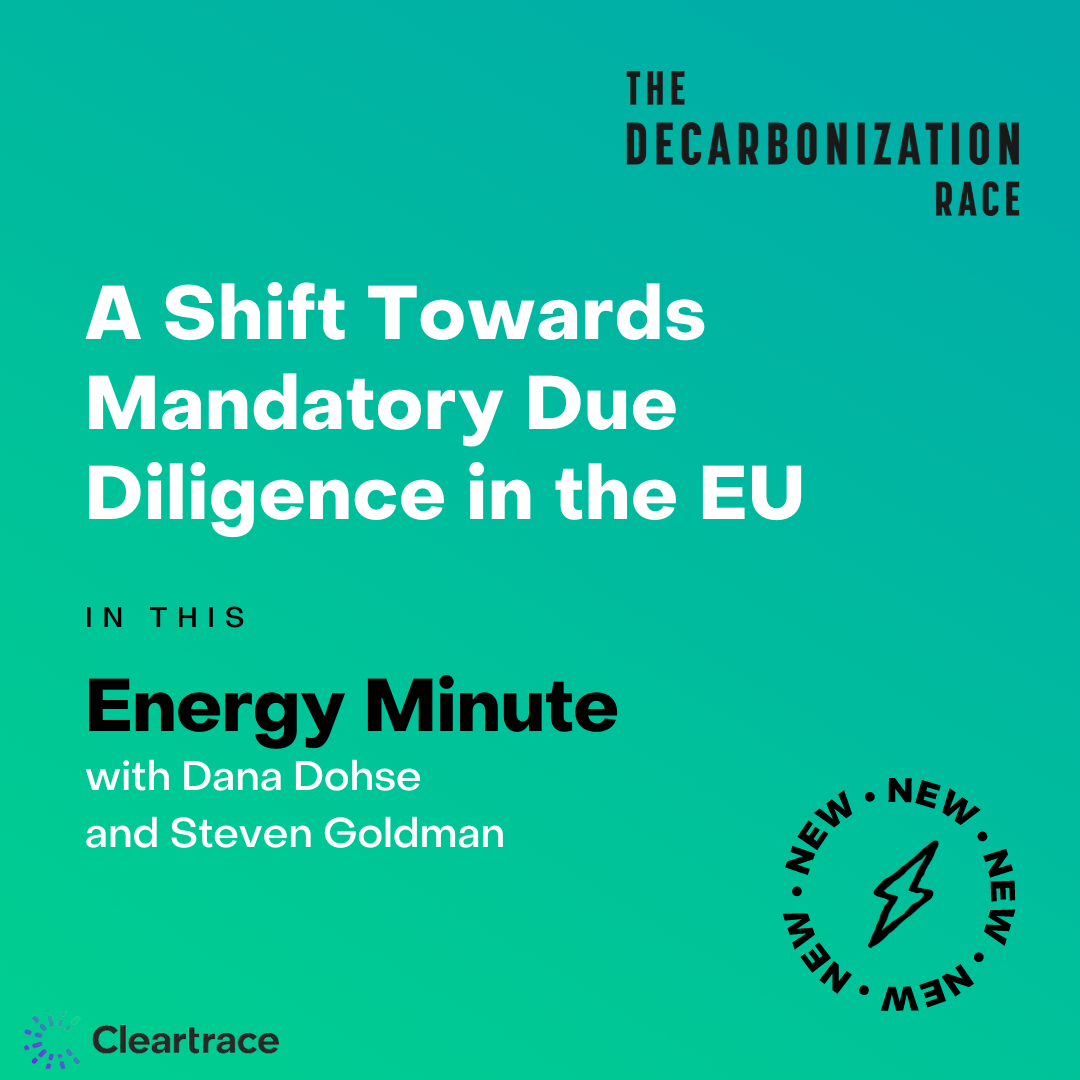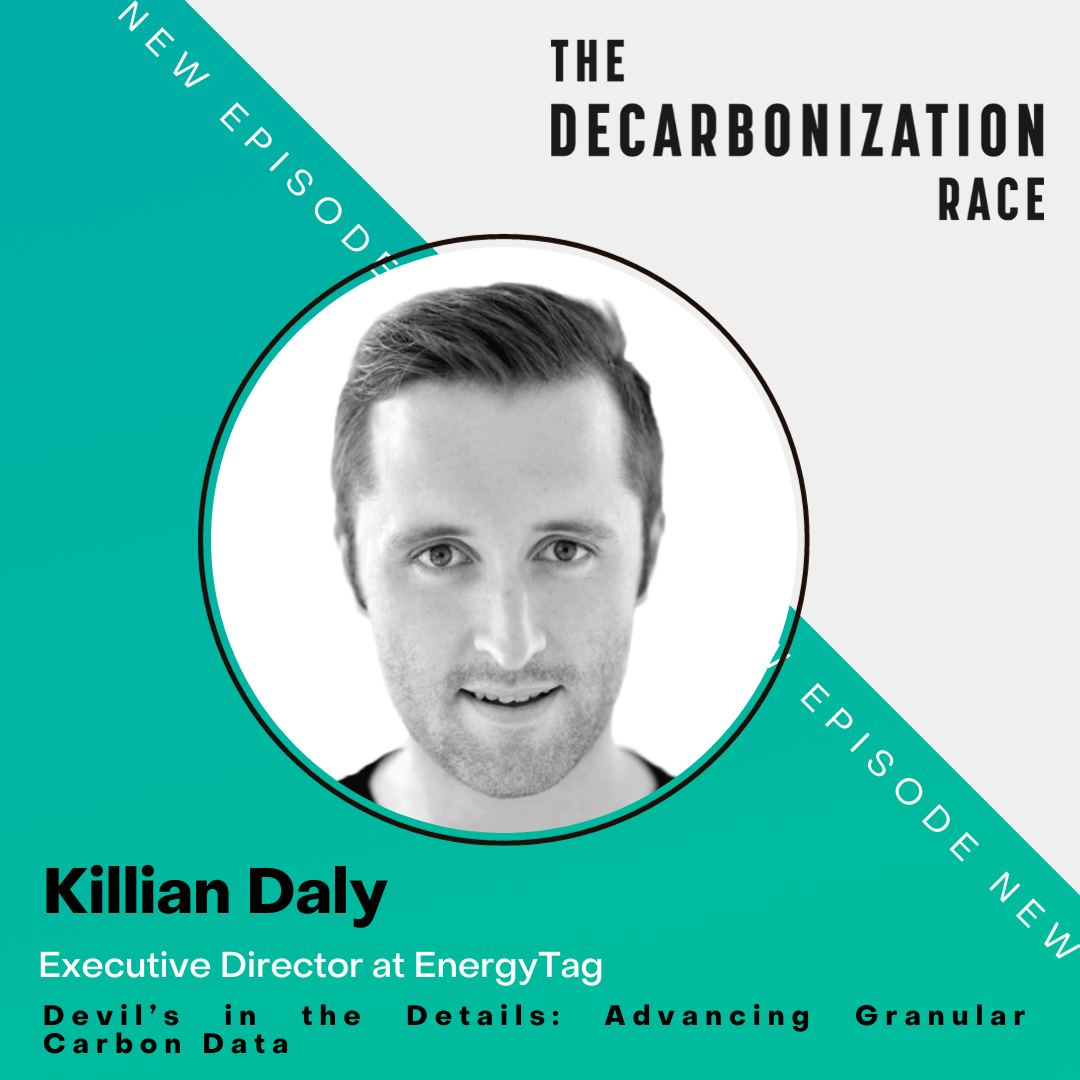Energy Minute: A Shift Towards Mandatory Due Diligence on Sustainability in the EU
In this Energy Minute episode, Dana Dohse and Steven Goldman jump into the European Union's Corporate Sustainability Due Diligence Direction (or CS3D for short) recently passed by the European Parliament. While the CS3D is not a regulation -- meaning member states will have several years to develop their own respective national laws on implementing the directive -- it still holds significant weight, and will impact both EU-headquartered companies as well as non-EU firms exporting goods via the EU or with significant operations in the EU.

In this Energy Minute episode, Dana Dohse and Steven Goldman jump into the European Union’s Corporate Sustainability Due Diligence Direction (or CS3D for short) recently passed by the European Parliament. While the CS3D is not a regulation — meaning member states will have several years to develop their own respective national laws on implementing the directive — it still holds significant weight, and will impact both EU-headquartered companies as well as non-EU firms exporting goods via the EU or with significant operations in the EU.
Compliance with the due diligence requirements will involve various jurisdictions and mechanisms, making it a complex endeavor for companies, meaning companies need to pay close attention as EU member nations issue their own regulations to better understand the impacts to their operations. The directive will have significant implications for corporations’ sustainability planning, alignment with the Paris Agreement, and require a greater understanding of supply chain risks.
Listen in as Dana and Steven dig into this environmental and human rights legislation and its implications for companies operating in the EU, and explore the potential costs and benefits for companies in different high-impact sectors, the role of due diligence in risk management and the impact on local communities.
Key Takeaways
- The EU is imposing a higher level of diligence than other parts of the world, which means that non-EU firms exporting goods via the EU or linked to EU companies will be impacted. Compliance with due diligence requirements will involve various jurisdictions and mechanisms, creating new costs and uncertainties for companies.
- The CS3D is a piece of legislation passed by the European Parliament that requires EU and non-EU companies to comply with due diligence requirements to operate in EU markets. This directive applies to companies based on their headcount or turnover thresholds, depending on if they operate in a high impact sector. This means that companies need to have a clear understanding of their eligibility for the requirements of CS3D and properly classify their business to meet the criteria during two consecutive financial years.
- The directive will lead to changes in internal controls and business procedures that companies will need to put in place to comply with the directive. Companies will bear the cost of establishing and operating due diligence procedures as part of their business procedures, and may have to pay up to 5% of their global turnover as damages in case of non-compliance. These costs are significant and will add up over time, causing a financial incentive for companies to comply.
Resources
- European Union information page on the CS3D: https://commission.europa.eu/business-economy-euro/doing-business-eu/corporate-sustainability-due-diligence_en
- KPMG on the CS3D: https://kpmg.com/xx/en/home/insights/2023/02/the-eu-corporate-sustainability-due-diligence-directive.html
Transcript
Dana Dohse: Welcome to this Week’s Energy Minute, brought to you by Cleartrace. I’m Dana Dohse.
Steven Goldman: And I’m Steve Goldman.
Dana Dohse: On our last Energy Minute, we looked at one of the several critical new pieces of legislation issued by the European Union that have far-reaching impacts for ESG and sustainability reporting for both companies based in and with significant operations in the EU.
Steven Goldman: This week, we’re looking at another, the Corporate Sustainability Due Diligence Directive, or CS3D, which will commit companies, including those in financial services, to demonstrate what action they’re taking to protect the environment and human rights, including in their supply chain.
Dana Dohse: So the goal is to press companies to identify and prevent, bring to an end, or mitigate the actual and potential impacts of their activities on the environment and on human rights abuses, and it’s a huge leap forward from voluntary commitments and acting on pressure from stakeholders.
Steven Goldman: The targets for compliance are further out than the corporate sustainability reporting directive that we covered on the last Energy Minute starting in 2030, but we wanted to look at this new set of regulations ahead of the release of the finalized SEC rules on climate-focused disclosures, and share a glimpse of how the EU is pulling the world along, in a similar manner as California often pulls the rest of the United States along into stronger environmental positions as they have a vehicle efficiency standards and other measures that are aimed at combating climate change.
Dana Dohse: So in this Energy Minute, we’re looking at the European Union’s CS3D, the Corporate Sustainability Due Diligence Directive. Let’s dive in.
So the goal of the Corporate Sustainability Due Diligence Directive, which we’ll refer to as CS3D for short, is to harmonize national legislation on corporate sustainability related to due diligence in EU member states. And thereby, it’s ensuring a level playing field, lowering the administrative burden, and bringing clarity for companies.
Steven Goldman: So what it’s obliging companies to do is to conduct due diligence not only on their own operations, but also on the activities of subsidiaries and other entities in their value chains that they have a direct or indirect established business relationship with.
Dana Dohse: And to comply, so companies, they need to implement what they’re referring to as a Prevention Action Plan. They need to obtain contractual assurances from their direct business partners they would comply with the plan and subsequently verify a compliance. So it’s setting goals that are holding companies accountable for their entire supply chain and the human rights associated with that.
Steven Goldman: Exactly. And it’s moving beyond, I think the CSRD fundamentally is about reporting, whereas this is more about doing due diligence and taking action to respond to identified risk.
Dana Dohse: Yes, absolutely. And I think before we dive in too much further, I think it’s important to call out the distinction here of a directive versus legislation. So the CS3D is an EU directive, not regulation, so it’s the weaker of the two legislative powers that the European Parliament has. And a directive give member states several years to develop their own national laws reflecting the directive and historically is a really dragged out. If we think about this from a U.S. perspective, it’s very similar to the U.S. [federal] government setting rules for states to then implement. And on the other hand, a regulation is more instant and applies equally to member states, so it’s far more powerful. So even if the CS3D emerges from that sausage machine is an actual directive, maybe this year or next year, it wouldn’t be until 2026 or 2027 before the actual states do anything about it.
Steven Goldman: But the reason we’re talking about it now is there’s a range of different moves around the world on strengthening corporate sustainability reporting, and not just the E in the ESG, but the S and the G, so social impacts, how corporations are governing themselves, what controls they’re putting into place. So the due diligence directive is jumping into that fray where it’s not just simply about reporting what you’re doing, but it’s ensuring that companies are putting internal controls in place and executing programs that are going to help actually manage those risks.
Dana Dohse: Absolutely. And one thing that really stood out to me is this is showing that sustainability, it goes far beyond the environment. So we’re looking at everything from human rights to environmental due diligence. So in the human rights front, it’s aligning to the UN’s guiding principles on business and human rights. And then on the environmental front, it’s essentially aligning to the Paris Agreement.
Steven Goldman: And it’s about making sure that the business models and strategies are aligned. This is representing really a huge shift away from voluntary commitments from companies simply setting aspirations to saying, “No, you need to build plans that are going to put you in compliance with both the guiding principles and the Paris Agreement. This isn’t a nice to have, this is you need to be moving in the right direction.”
Dana Dohse: Yes, it’s definitely adding some teeth behind some of the legislation that’s been, to your point earlier, more focused on that reporting aspect.
Steven Goldman: What we’re seeing from this is the likelihood there’s going to be a greater impact on non-EU firms that are exporting goods through the EU or multinationals that are linked to companies within the EU because this is going to have broader reach than simply reporting requirements. There’s more jurisdictions involved in complying with the requirements around due diligence, and it’s applying a level of diligence that’s not being mandated elsewhere in the world, and there’s going to be compliance mechanisms behind that to ensure they meet those obligations. So at the end of the day, non-EU firms may find themselves having to comply with requirements that they would not have anticipated otherwise. In order to stay participants in EU markets, they need to be working to comply.
Dana Dohse: Right. And not only that, it’s also a really big shift in terms of tying impacts to actual compensation. So the directive will make companies implement a transition plan that’s in line with Paris Agreement, and it requires directors of companies with more than 1,000 employees to be responsible for implementing the plan. So in addition, the effectiveness of the transition plan will be linked to executive bonuses, so that’s a pretty big change.
Steven Goldman: If there’s anything that’s going to move the world, it’s going to be executive bonuses.
Dana Dohse: Yes, that’s something that unites cultures.
Steven Goldman: The other thing this is going to introduce is there’s duties for the directors of the EU companies that are being covered. It’s requiring them to get deep into the process of setting up and overseeing the implementation of due diligence processes and integrating due diligence into corporate strategy. Now, what we’ve seen previously is those are well understood as part of company’s enterprise risk management systems overall. This is the fabric of how companies look across their operations, gauge risk, and work to manage those over time, but those are typically voluntary business processes. These are things that companies do to protect themselves, but not necessarily driving towards big external goals unless there’s a direct relationship, but that kind of reporting and that kind of due diligence is in the essence of what the SASB and now ISSB sustainability standards are based.
So the fact that this is going to now move companies to making these kinds of due diligence requirements mandatory is a big shift. So Dana, what categories of companies are subject to this? There’s already been some evolution of the discussion from the EU from the proposed rule already to refined versions of it we’ve been seeing discussed as they work towards finalization.
Dana Dohse: So this is obviously subject to change, and we’ve seen it changed several times as different people have discussed this over the years. So simply put, its EU and non-EU based company’s overhead count or turnover threshold, depending on if they operate in a high impact sector. The first set of companies subject to the CS3D’S requirements are very large companies, meaning those with more than 1,000 employees and a worldwide net turnover of 300 million euros. This also applies to non-EU companies with 300 million turnover just in the EU, and those will come into force within three years after the directive is finalized. So after the very large companies, there’s what we’re calling group one companies, which follow four years after the CS3D goes into effect. So group one companies are non-EU based limited liability companies with a net turnover in excess of 150 million in the EU in the financial reporting year preceding when it comes into effect.
And then so for EU based companies, it refers to those with the same net turnover requirement and more than 500 employees. So for group one, if you put that number into perspective, there are about 30 million companies in the EU. So that 9,000 is about 3%, so it’s not a huge percentage overall. And the last group, referred to as group two, will follow five years after the CS3D goes into effect, and that’s when things get a little more complicated. So for EU based companies, group two refers to companies with a net turnover and excess of 40 million euro, but not exceeding 150 million in the EU in the financial year preceding the last financial year, and they have the same provision that at least 50% of the net worldwide turnover needs to be generated in one or more of these high risk sectors. So Steven, I think you did some research around these sectors. What are they talking about here?
Steven Goldman: If that all wasn’t confusing enough, it’s only companies that meet the criteria during two consecutive financial years fall within the scope of the CS3D, so it’s going to be important for companies to have a very clear picture of where they stand and when they’ve stood there in order to know if they’re eligible for the requirements of the CS3D. Now, when they talk about high impact sectors, there’s really three big areas that are identified so far. One is manufacturing of textiles, leather, and related products, and the wholesale trade of textiles, clothing, and footwear. Two is agriculture, forestry, and fisheries, including aquaculture and the manufacturer of food products and the wholesale trade of agricultural raw materials, live animals, wood, food, and beverages, so anything you would think of that is raised, that is grown, and that is turned into products based on them.
And then lastly, minerals and metals, and then the related goods, so extraction of any mineral resources regardless from where they’re coming from, the manufacturing of basic metal products, things based on minerals, and then the wholesale trade of those mineral resources and metal resources. So those essentially extractive industries that require certain kinds of resources to make them, IE animals, IE fish, IE agriculture, forestry, et cetera.
Dana Dohse: Right. And this is a really interesting list when you put it in the context of the human rights piece of this directive. So it’s really thinking about your entire supply chain and adding a level of responsibility for corporations to really think about and then being held accountable for the suppliers that they use within their business.
Steven Goldman: Exactly. And it gets also into concerns that are raised by a lot of NGOs around equity, where if you’re talking about agriculture, there are local community concerns of whether you’re taking resources that belong to the community or should be accessed first and foremost by the community. If you’re talking about fisheries, if you’re talking about excessive agriculture where you could have runoff that has impacts on waterways, if you’re talking about mineral extraction and whether or not you have the rights to do that. You can have externalities that are affecting the local communities around you. And this could also apply to power generation. One of the biggest issues that coal plants have faced is not strictly the carbon emissions they’re putting out, not strictly the pollutants coming out of their smoke stack, but it’s also you can have [inaudible 00:11:24] effects from say coal ash that’s being stored near communities and could potentially leak into water supplies or get blown into nearby communities.
This covers a wide range of areas that shift from what we think of as traditionally environmental into social impacts on communities and justice issues frankly. But it gets interesting when we talk about the rule enforcement, then we start looking at EU member state responsibilities versus federalism, for lack of a better term, of where the EU sits in terms of authority.
Dana Dohse: So how will these be enforced? I think you did a bit of research on this area.
Steven Goldman: Right. So the EU member states are going to be responsible for deciding how and by whom the implementation of the directive is going to be handled, and then as a result, be responsible for imposing effective proportionate and dissuasive sanctions. So that can include fines, that can include compliance orders. The EU is going to sit over that and set up an authority of authorities, basically a network of the representatives of the national bodies to make sure they take a coordinated approach. But then at the end, it’ll be up to the EU member states to ensure that victims get compensated if there are damages resulting from failure to comply with the obligations of the new proposals.
The EU is essentially setting the tone as saying, “You need to build the structures in place the same way that the directive itself is ordering companies to put internal controls into place.” The EU is essentially asking the member states, “You need to build the internal controls to monitor the internal controls of corporations and make sure that they are doing the diligence they need to.” So the big question I think this begs is what is this going to mean to companies, and particularly in terms of cost?
Dana Dohse: Right. So companies, they’re going to face costs of establishing and operating the due diligence procedures first and foremost. They have to figure out how to operationalize this and make it part of their business procedures. But secondly, this is particularly interesting because within this proposal, companies may have to pay up to 5% of their global turnover as damages, and this might be one of the highest percentages we’ve seen for due diligence legislation, which makes us question whether or not it’s going to pass in its current form. What this means is that companies found to be responsible for serious human rights abuses or environmental damages could be held accountable for substantial amount of money.
So that 5% turnover provision has been met with both praise and criticism across the EU. So supporters are arguing that it will encourage companies to take the environmental and social responsibilities seriously and that will have a financial incentive to do so. And on the other hand, critics argue that the provision may be too severe and the threat of such large fines could cause businesses to become overly cautious and avoid taking risks which could ultimately harm innovation and economic growth.
Steven Goldman: I think the argument you can make there though is if they start out overly harsh, it’s going to cause businesses to readjust the lens they take on risk.
Dana Dohse: Absolutely. It’s also important to note that the 5% is not a fixed penalty, so it’s the max penalty that companies may face under how it’s written today. So it’s more of a ramping scale.
Steven Goldman: And then the other piece is they’re going to have transition costs, right? They’re going to have the expenditures and investments that are required to change their operations and their value chains to comply, so that’s going to add a different layer of cost, but one that could drive innovation hopefully. As we said before, the hope is that if the directive is designed robustly, if the implementation at the state level is similarly robust, that this directive could elevate the kinds of internal controls and due diligence around environmental concerns and human rights issue management that to date were largely voluntary goals and a question of internal controls and evolve that into a new EU wide framework. It’ll require companies that are in the EU or engage in significant business in the EU to better understand the risks in their supply chains, much the way that companies are working to understand that their carbon footprint are now having to assess scope three emissions with their suppliers.
Dana Dohse: And this kind of due diligence has significant implications for our listeners’ companies and their sustainability plans. So for those working to source clean energy, for example, they would need to put the right internal controls in place to avoid forced labor in their solar energy supply chains. They’d also need to understand where the rare earth elements used, the wind turbines they procure came from. A range of those companies would be obliged to ensure their business models and strategies are compatible with the Paris Agreement. And so additionally, for companies that identify climate change as a principle risk for or a principle impact from their operations, they would also include emissions reduction objectives in their business plans.
Steven Goldman: So it’s basically a sea change in how companies have to manage risk across their processes, their operations, the ways that they source, and the ways that they produce the goods and services that they deliver into the world.
Dana Dohse: Absolutely. It’s really taking that wider lens, looking at the full ESG picture, not just your environmental footprint, going beyond reporting, and it’s starting to really be a pretty far-reaching impact as we think through how this could affect not only the business operations, but how a company thinks about innovation.
Steven Goldman: So as we wrap up, these rules aren’t final yet. They’re still being deliberated among the European Parliament and working towards finalization, but I would argue that they serve as another marker in just how quickly and profoundly the landscape and requirements around sustainability are changing.
Dana Dohse: Absolutely. And companies need to stay abreast of these changes and really be working to understand how to build the right internal controls, how to identify risks and existing impacts, and then how to develop programs to address them.
Steven Goldman: And we’ll keep monitoring both the evolution of the CS3D of the corporate Sustainability Reporting Directive that we talked about on the last Energy Minute, and of course the SEC rules on climate focus disclosure as those head towards finalization this fall.
Dana Dohse: Thanks for joining us for this week’s Energy Minute. For more of the latest news in sustainability and decarbonization, visit Cleartrace.io.










